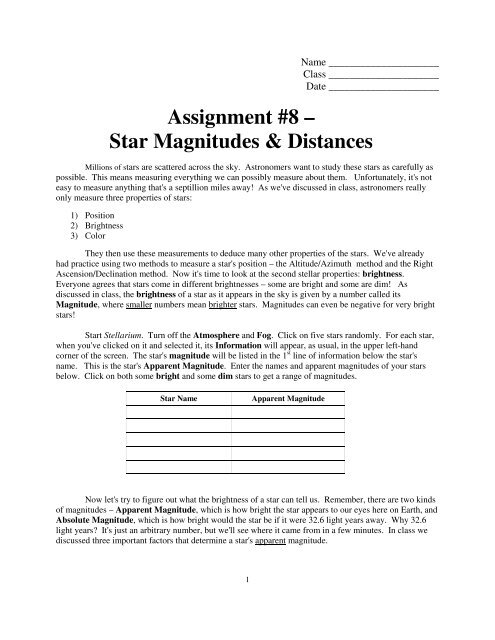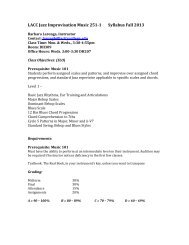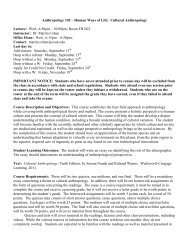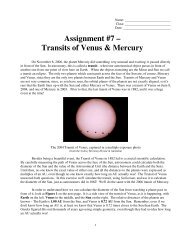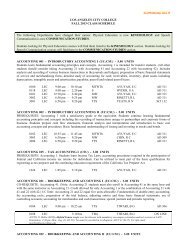Assignment #8 – Star Magnitudes & Distances - Faculty Web Pages
Assignment #8 – Star Magnitudes & Distances - Faculty Web Pages
Assignment #8 – Star Magnitudes & Distances - Faculty Web Pages
You also want an ePaper? Increase the reach of your titles
YUMPU automatically turns print PDFs into web optimized ePapers that Google loves.
1<br />
Name _____________________<br />
Class _____________________<br />
Date _____________________<br />
<strong>Assignment</strong> <strong>#8</strong> <strong>–</strong><br />
<strong>Star</strong> <strong>Magnitudes</strong> & <strong>Distances</strong><br />
Millions of stars are scattered across the sky. Astronomers want to study these stars as carefully as<br />
possible. This means measuring everything we can possibly measure about them. Unfortunately, it's not<br />
easy to measure anything that's a septillion miles away! As we've discussed in class, astronomers really<br />
only measure three properties of stars:<br />
1) Position<br />
2) Brightness<br />
3) Color<br />
They then use these measurements to deduce many other properties of the stars. We've already<br />
had practice using two methods to measure a star's position <strong>–</strong> the Altitude/Azimuth method and the Right<br />
Ascension/Declination method. Now it's time to look at the second stellar properties: brightness.<br />
Everyone agrees that stars come in different brightnesses <strong>–</strong> some are bright and some are dim! As<br />
discussed in class, the brightness of a star as it appears in the sky is given by a number called its<br />
Magnitude, where smaller numbers mean brighter stars. <strong>Magnitudes</strong> can even be negative for very bright<br />
stars!<br />
<strong>Star</strong>t Stellarium. Turn off the Atmosphere and Fog. Click on five stars randomly. For each star,<br />
when you've clicked on it and selected it, its Information will appear, as usual, in the upper left-hand<br />
corner of the screen. The star's magnitude will be listed in the 1 st line of information below the star's<br />
name. This is the star's Apparent Magnitude. Enter the names and apparent magnitudes of your stars<br />
below. Click on both some bright and some dim stars to get a range of magnitudes.<br />
<strong>Star</strong> Name Apparent Magnitude<br />
Now let's try to figure out what the brightness of a star can tell us. Remember, there are two kinds<br />
of magnitudes <strong>–</strong> Apparent Magnitude, which is how bright the star appears to our eyes here on Earth, and<br />
Absolute Magnitude, which is how bright would the star be if it were 32.6 light years away. Why 32.6<br />
light years? It's just an arbitrary number, but we'll see where it came from in a few minutes. In class we<br />
discussed three important factors that determine a star's apparent magnitude.
• What three factors determine a star's apparent magnitude (how bright the star will appear to be in<br />
our night sky)? Note - two are lumped together and called "Luminosity" ____________________<br />
_______________________________________________________________________________<br />
Let's examine more closely Luminosity and Distance. Luminosity, as you remember from class,<br />
is a measure of how much total light a star gives off every second. It's basically the same thing as Absolute<br />
Magnitude.<br />
A star that looks dim to our eyes could be dim because it has a low luminosity, or because it is far<br />
away. Which one is it? If we could measure the star's distance, then we could answer that question.<br />
PART A<br />
Our first task is to measure a star's distance. The most accurate way to do this is to use parallax.<br />
As we discussed in class, parallax is the word we use to describe how something appears to shift its<br />
position relative to the background when we look at it from two different angles. In the case of stars, those<br />
two angles are provided by looking at the star on two nights that are six months apart <strong>–</strong> that way we are<br />
seeing the star from two points on opposite sides of the Earth's orbit around the Sun. This picture helps<br />
explain it:<br />
Unfortunately, the stars are all so far away that the amount they shift in the sky over the course of a<br />
year is very small <strong>–</strong> we're talking about arc seconds of angle (remember, one arc second is 1/3,600 of a<br />
single degree)! Astronomers have defined a distance, called a Parsec, which is the distance a star has to<br />
be from Earth to shift its position by one arc second in the sky over the course of six months. A parsec<br />
turns out to be 3.26 light years. To measure a star's distance, then, just observe that star for a year, and<br />
measure its parallax (in arc-seconds) during that time, and then you can use the following formula to<br />
calculate its distance:<br />
D= 1<br />
p<br />
Equation 1<br />
2
Where D is the star's distance (in parsecs), and p is the star's parallax, in arc-seconds. What the<br />
equation shows us is that the more a star shifts its position (in other words, the greater its parallax is), the<br />
closer it is!<br />
Let's calculate the distances to some stars. In Stellarium, search for the stars in Table 1 on the next<br />
page using the Search Window (or by simply pressing F3), and when you've selected them, look in their<br />
Information in the upper left-hand corner of the screen. Their parallax is listed on the last of information,<br />
and their distance is listed on the line just above that. For each star record its apparent magnitude in the<br />
second column, its parallax in the third column, and its distance in the fourth column.<br />
<strong>Star</strong> name Apparent<br />
magnitude<br />
Sirius<br />
Aldebaran<br />
Betelgeuse<br />
Proxima<br />
Spica<br />
Barnard's <strong>Star</strong><br />
Deneb<br />
Vega<br />
Arcturus<br />
Altair<br />
Parallax<br />
(arc seconds)<br />
Table 1<br />
Distance, in light years<br />
(from Stellarium)<br />
3<br />
Distance, in parsecs<br />
( using Equation 1)<br />
Distance, in light years<br />
(using 1 parsec = 3.26 ly)<br />
Now calculate the distances to each of these stars, using each star's parallax and Equation 1.<br />
Enter the results in the fifth column of Table 1. KEEP ONLY TWO DECIMAL PLACES IN YOUR<br />
ANSWER!<br />
Since Equation 1 gives you the distance in parsecs, we'll need to convert each distance from<br />
parsecs to light years, using the fact that one parsec = 3.26 light years. Multiply each distance by 3.26 to<br />
get the distance in Light Years, and then enter the result in the sixth column of Table 1.<br />
• Do your calculated distances for the stars (Column 6) agree with what Stellarium lists for each<br />
star's distance (Column 4)? _________________________________________________________<br />
Parallax is a powerful and relatively simple way to measure the distance to stars. Unfortunately,<br />
most stars are too far away for us to to measure their parallax <strong>–</strong> they just move too little in the sky to be<br />
observed. For these stars we will need to find another way to measure their distance.<br />
PART B<br />
Now let's think about the difference between Absolute and Apparent magnitude. In the line<br />
below the star's Apparent Magnitude, Stellarium lists the stars Absolute Magnitude. For each star how<br />
bright the star appears to our eyes here on Earth. But some stars appear bright simply because they're<br />
nearby. If the stars in Table 1 were all put at the same distance away, say 10 parsecs (32.6 light years),
we would then be able to tell which star was intrinsically or naturally brighter. No star would have an<br />
unfair advantage in being bright by virtue of the fact that it was close by! Put a star 10 parsecs away and<br />
then measure how bright it appears to be, and you have that star's Absolute magnitude.<br />
• If the star is farther than 10 parsecs away, which will be a larger number, it's apparent or absolute<br />
magnitude? REMEMBER, A LARGE MAGNITUDE MEANS DIM, AND A SMALL<br />
MAGNITUDE MEANS BRIGHT! _______________________________________________<br />
• If the star is closer than 10 parsecs away, which will be a larger number, it's apparent or absolute<br />
magnitude? ______________________________________________________________<br />
• Look at the distances and apparent magnitudes of the stars in Table 1. Which of these stars do<br />
you think would have the largest absolute magnitude? In other words, which star would be<br />
dimmest if it were 10 parsecs away? Why? ___________________________________________<br />
______________________________________________________________________________<br />
• Check your answer. Look up the Absolute <strong>Magnitudes</strong> of the stars from Table 1 (the 2 nd line in the<br />
information listed in Stellarium). Which star has the largest Absolute Magnitude? ____________<br />
What is its Absolute Magnitude? ___________________<br />
• Look at the stars in Table 1. Which of these stars do you think would have the smallest absolute<br />
magnitude? In other words, which star would be brightest if it were 10 parsecs away? Why?<br />
________________________________________________________________________<br />
• Check your answer. Look up the Absolute <strong>Magnitudes</strong> of the stars from Table 1. Which star has<br />
the smallest Absolute Magnitude? ____________ What is its Absolute Magnitude?<br />
___________________<br />
So there's a connection between a star's apparent magnitude, its absolute magnitude, and its<br />
distance. If you know any two of these three quantities, you can figure out the third! There's a neat<br />
mathematical way to connect these three quantities. Let's say M is a star's absolute magnitude, m is the<br />
star's apparent magnitude, and D is its distance, in parsecs. Then the following is true:<br />
M = m <strong>–</strong> 5 * [ log(D) <strong>–</strong> 1 ]<br />
Equation 2<br />
4
If you've never seen the math term log before, the log or logarithm of a number is the power that<br />
you have to raise 10 to to get that number. In other words, log 10 = 1, log 100 = 2, log 1000 = 3, etc. Most<br />
scientific calculators have a log button. If you don't have one, you can use this web site:<br />
http://www.motionnet.com/calculator/<br />
With a little algebra, we can rewrite Equation 2 as<br />
D = 10 (m-M+5)/5<br />
Equation 3<br />
For each of the stars in Table 1, use Equation 2 to calculate the star's Absolute Magnitude, M.<br />
Enter the results in Table 2 below. Remember, you have each star's Distance and Apparent magnitude<br />
in Table 1!<br />
Table 2<br />
<strong>Star</strong> name Absolute Magnitude <strong>Star</strong> name Absolute Magnitude<br />
Sirius Barnard's <strong>Star</strong><br />
Aldebaran Deneb<br />
Betelgeuse Vega<br />
Proxima Arcturus<br />
Spica Altair<br />
Remember, you can check your results in Table 2 by looking up the information on the stars in Stellarium!<br />
• Which of these stars has the greatest Absolute magnitude (i.e., was the dimmest)? _____________<br />
• Which of these stars has the least Absolute magnitude (i.e., was the brightest)? ________________<br />
• Suppose I found a star whose Absolute Magnitude was 1, and its apparent magnitude was 6. How<br />
far away is that star? (Use Equation 3) _________________________________________<br />
• Suppose I found a star whose Absolute Magnitude was 6, and its apparent magnitude was 1. How<br />
far away is that star? (Use Equation 3) _________________________________________<br />
There's a simple (but sometimes confusing!) connection between how bright a star really is, how<br />
bright it appears to be, and how far away it is. Understanding that connection allows us to figure out these<br />
three important properties of stars, furthering our understanding of the universe.<br />
5
Write a conclusion explaining what you learned in this exercise.<br />
______________________________________________________________________________________<br />
______________________________________________________________________________________<br />
______________________________________________________________________________________<br />
______________________________________________________________________________________<br />
______________________________________________________________________________________<br />
______________________________________________________________________________________<br />
______________________________________________________________________________________<br />
______________________________________________________________________________________<br />
______________________________________________________________________________________<br />
______________________________________________________________________________________<br />
6


